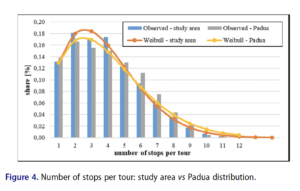Freight vehicle origin-destination (O-D) matrices play a key role within the assessment procedures of city logistics scenarios, and simulation of delivery tours allows such O-D flows to be obtained. A recent paper revisits a modelling framework for simulating delivery tours using an aggregate approach of implementing a real test case using the global position system (GPS) traces. These GPS traces were used to extract vehicle tours/trip chains which are available on a large scale for such uses as fleet management or vehicle insurance. The modeling framework was calibrated using a dataset of light goods vehicles operating in the Veneto region (Italy) for which automated vehicle monitoring (AVM) data were available. The results show that such an approach enables satisfactory results to be obtained in terms of freight distribution O-D matrices.
Further research will cover the influence of socio-economic attributes (such as retail size) on tour definition, the size function in delivery location choice, modeling of the choice set generation within the delivery location model, and departure time choice vis-à-vis the relationship with time window access restrictions.
Source: (2021) Aggregate delivery tour modeling through AVM data: experimental evidence for light goods vehicles, Transportation Letters, DOI: 10.1080/19427867.2020.1868178

